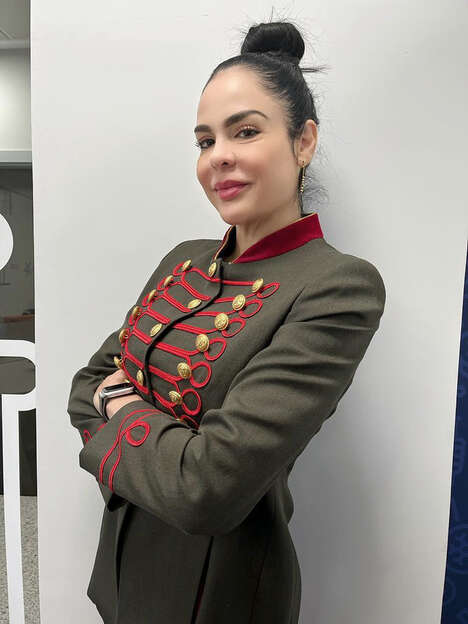Moving at the Speed of Science
Anna Maria Marra, Sr. Director, Global Biopharma Operations, Pfizer
 Known for its "relentless pursuit of scientific breakthroughs and revolutionary medicines that will create a healthier world for everyone," Pfizer is one of the world's leading biopharmaceutical companies. Anna Maria Marra is Sr. Director of Global Biopharma Operations at Pfizer and believes that it's important to empower innovation teams to take risks while encouraging a culture of collaboration and trust.
Known for its "relentless pursuit of scientific breakthroughs and revolutionary medicines that will create a healthier world for everyone," Pfizer is one of the world's leading biopharmaceutical companies. Anna Maria Marra is Sr. Director of Global Biopharma Operations at Pfizer and believes that it's important to empower innovation teams to take risks while encouraging a culture of collaboration and trust. 1. What does innovation mean to you?
For me, innovation means implementing ideas that change the way we do things and result in an improvement. It could be a new good or service, something that, in the end, generates value. Sometimes, we think that innovation could be just launching a new product or service, but I think it goes above that. For me, it's about anything that generates value, even if it's an improvement in a process.
2. How does your team generate new ideas?
To give you a little background, my team is the internal agency inside Pfizer. For us, generating new ideas is our day-to-day, our bread, and butter. We have many ways to create new ideas, but we usually have brainstorming sessions and specific creative processes. This process can include Agile or Waterfall methodologies, depending on the type of project, but we also try to develop new concepts daily due to the nature of our work.
3. Do you have any specific rituals for resetting your team to be more creative?
We host a quarterly meeting called 'The Sound of Ideas' to get together and share projects the team has worked on. We also do some experimentation, especially internally. We also involve the team in training with external parties from other industries. For example, for two years, we worked with a cool hunter from the fashion industry, with whom the team met once a week to discuss trends. Consequently, the team got a sense of how other sectors innovated; during the sessions, we discussed ideas across fashion, retail, consumer goods, and even art.
4. How do you identify trends? What resources does your team use to spot trends and consumer insights?
There are many sources that we use. We rely on secondary market research data from brand strategic plans that are primarily market research, along with observation and social listening. We also use Trend Hunter reports monthly and try to do a curation with the reports we receive. They're now related to healthcare and consumer goods, and we look across various angles. Depending on the product or challenge, we will use a combination of the sources I just mentioned and incorporate and validate them. I think it's a little bit of what everyone uses across every industry.
5. What is the biggest challenge you face when innovating?
Some of the biggest challenges we face when innovating, no matter how large or small the team or organization is, are a fear of change and a lack of ownership of the innovation process. At Pfizer, we have worked hard from the top of the organization to solve these. My internal creative agency team's biggest challenge is convincing clients to try something new, such as new creative concepts or trends in the advertisement industry. As the organization moves into an innovation mindset, the buy-up for innovative ideas has changed, and marketing is more open to experimentation.
6. Has there ever been an instance where another industry has influenced Pfizer?
Yes, we have incorporated learnings and taken inspiration from other sectors such as software, retail, fashion, and entertainment. As with any innovation, change management and some time is needed to introduce new concepts. However, some of these concepts were successfully approved and implemented with teamwork and the right strategy.
One specific example was an awareness campaign for the general public about antimicrobial resistance, a highly complex topic related to superbugs and infections. It was pre-COVID, so we thought about ways to translate this complex scientific topic for the general public in a fun way.
We created a Disney-like experience called the Bug Bus, an actual bus that departed from London, crossing Europe, and stopping in Paris, Madrid, and Rome. People could get inside the bus and participate in an immersive interactive experience, similar to a Disney game or amusement park, informing them of how ordinary citizens could contribute to reducing antimicrobial resistance. We also developed interactive games, such as taking a selfie with a superbug, and people could share what they learned on social media. It was a very successful project, and we even received external recognition by the Life Science Excellence Awards in Italy as one of the best programs directed to patients. So what inspired us, in that case, was entertainment and the idea of making learning fun and interactive for people.
7. What makes an innovative culture and how do you create a culture of innovation?
It's essential to empower your team to take risks. When thinking and proposing ideas, you must make sure people feel trusted and give permission for trial and error. People need to be free to take risks and be inspired. It also helps to have a culture of collaboration where colleagues, regardless of their level– feel confident–, to bring ideas to the table.
For me, any idea is welcomed as a part of my team. It doesn't matter if you are the director or the designer; no idea is bad when we are in a brainstorming session. I think that leaders need to be transparent, communicate well and give people the confidence that we want them to take risks, think out of the box, and that we are here to back them up. Another critical element is a straightforward goal-setting approach and mission goals that encourage creative thinking. Lastly, it's essential to create incentives for employees to innovate. Ultimately, this can increase the quality of their work and build a culture of innovation.
We incentivize this by giving colleagues credit in their performance reviews for having the courage to innovate, despite the result. For us, it's an excellent way to keep people focused while ensuring they are rewarded for innovating.
8. Looking to the future. How will Pfizer continue to be a leader in innovation?
As a leader in innovation, we have been named one of the most impactful companies by Time Magazine in 2022, and that is due to our commitment to battling COVID. But moreover, we are innovating through changing our ways of working and incorporating Lightspeed principles into it. For example, in the fall of 2020, Pfizer coined the phrase "moving at the speed of science," knowing that time was our enemy. It still is. Every day matters for patients who have cancer or a rare disease. We finished the race for the vaccine at the speed of science, and we are now working to bring that urgency and speed to everything we do.
9. Can you speak about the Simplicity megatrend and its impact on Pfizer?
It's one of the big themes we are trying to work hard on in Pfizer to make things simpler and easier. One of the key steps we have taken as an organization, as part of our Lightspeed principles, is crushing the bureaucracy or "cutting the red tape."
For example, during our race to make the impossible possible (launching our COVID-19 vaccine), we focused only on the work, and we cut the red tape. Regardless of level, the right people, along with their managers, were invited to calls, and all would receive real-time updates. Not everyone had to attend every session, but it was made clear who held decision rights, regardless of level.
Pre-meetings were eliminated as there was no time for them. This fast, transparent way of working has become one of the hallmarks of the company and advances the simplicity theme. We are setting the stage, structures, and strategy we need to move forward on the simplicity path. Moreover, we are implementing Agile in all our marketing teams and everywhere to manage different projects.
References: pfizer
Featured Articles

Updated Detox
Digital detoxing becomes more integral for wellness-minded consumers

Custom Sleep
Personalized pillows and bedding allow for a fully tailored sleep experience

Corporate Health
Businesses prioritize mental health for employees and/or customers

Immersive Therapy
Virtual reality-based therapy experiences offer immersive treatments

Accessible Optometry
Some businesses are prioritizing affordable eye care and prescriptions